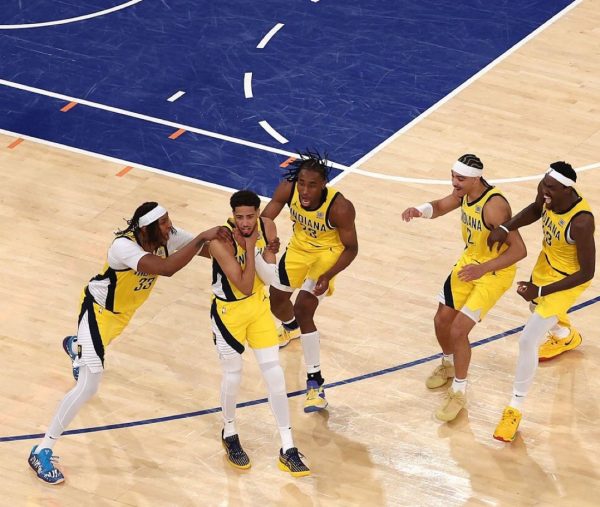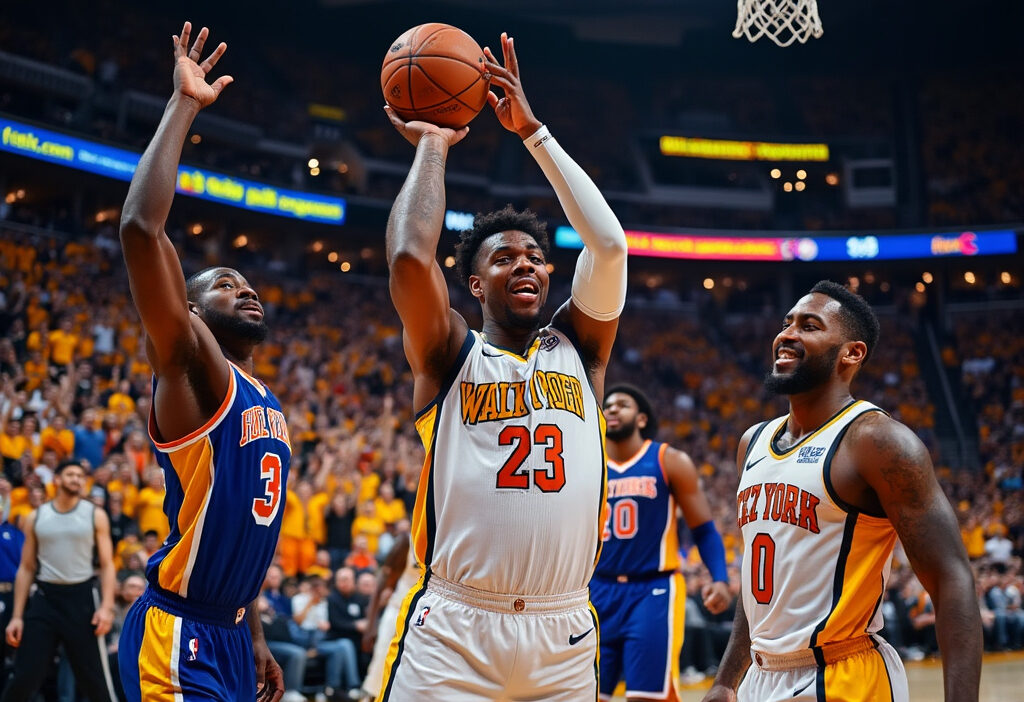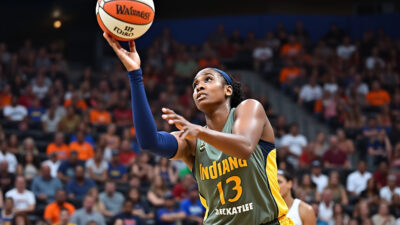Pacers Stun Knicks in OT Thriller to Take Game 1 of East Finals
In an unforgettable start to the 2025 Eastern Conference Finals, the Indiana Pacers orchestrated a stunning comeback against the New York Knicks, securing a 138-135 victory in overtime. This dramatic Game 1 at Madison Square Garden on May 21 has set the tone for what is expected to be an enthralling series between these storied rivals.
The Stage is Set
The energy inside Madison Square Garden was electric as the Knicks came out swinging in the first half, determined to assert their dominance early. Jalen Brunson set the tone with a blistering 12-point first quarter, slicing through the Pacers’ defense with his signature mid-range pull-ups and crafty finishes at the rim. New York’s ball movement was crisp, exploiting Indiana’s defensive rotations with pinpoint passes to open shooters like Donte DiVincenzo, who drained three first-half threes. The Knicks’ physicality on defense disrupted the Pacers’ up-tempo style, forcing Tyrese Haliburton into uncharacteristic turnovers and limiting his playmaking impact.
Indiana struggled to find offensive consistency, with Myles Turner’s early foul trouble compounding their issues. Pascal Siakam kept the Pacers afloat with 14 first-half points, attacking the rim aggressively, but the supporting cast shot a combined 35% from the field. The Knicks’ bench, led by Miles McBride’s pesky perimeter defense, extended the lead to as much as 12 in the second quarter. However, a late surge from Andrew Nembhard, including a buzzer-beating floater, cut the deficit to 58-49 at halftime. The Pacers’ resilience hinted at a brewing comeback, but New York’s control of the pace and paint—outrebounding Indiana 24-18—suggested they were firmly in command.
First Half Highlights
The first half of Game 1 at Madison Square Garden was a masterclass in New York’s ability to dictate the tempo early. The Knicks came out firing, with Jalen Brunson setting the tone by scoring 12 points in the opening quarter. His ability to penetrate the Pacers’ defense and either finish at the rim or kick out to open shooters kept Indiana scrambling. The Knicks’ offensive strategy revolved around high pick-and-roll actions, exploiting mismatches, and moving the ball quickly to find open looks. Donte DiVincenzo capitalized on this, draining three first-half threes to stretch the Pacers’ defense thin.
Defensively, New York was relentless. Mitchell Robinson anchored the paint with three early blocks, disrupting Indiana’s drives and forcing them into contested jumpers. The Pacers, usually a high-octane offensive team, looked out of sync, shooting just 38% from the field in the first half. Tyrese Haliburton struggled to find his rhythm, going 2-of-7 from the field, while Pascal Siakam was the lone bright spot with 10 points but lacked consistent support.
A pivotal moment came late in the second quarter when Brunson orchestrated a 10-2 run, capped by a step-back three over Haliburton to give New York a 54-45 halftime lead. The Knicks’ bench outscored Indiana’s reserves 18-9, with Josh Hart providing energy on both ends. The Pacers, meanwhile, seemed hesitant, their usually fluid ball movement stifled by New York’s physicality. The stage was set for a potential blowout—until the second half flipped the script.
Knicks Extend the Lead
The third quarter saw the New York Knicks tighten their grip on the game, methodically extending their lead to a commanding 17 points. With the halftime adjustments from coach Tom Thibodeau paying dividends, the Knicks came out with a renewed defensive intensity, stifling the Pacers’ transition game and forcing them into contested shots. Jalen Brunson continued his stellar play, orchestrating the offense with precision, while Josh Hart and Donte DiVincenzo provided the necessary secondary scoring to keep Indiana on its heels.
A pivotal moment came midway through the third when Brunson drained a step-back three-pointer over Andrew Nembhard, igniting the Madison Square Garden crowd. The Knicks’ ball movement was crisp, exploiting gaps in the Pacers’ defense with well-timed cuts and screens. Isaiah Hartenstein dominated the glass, securing multiple offensive rebounds that led to second-chance points, further demoralizing Indiana.
As the fourth quarter began, the Knicks showed no signs of slowing down. A 10-2 run early in the period, capped by a DiVincenzo corner three, pushed their lead to its peak. The Pacers, meanwhile, looked disjointed—Tyrese Haliburton struggled to find his rhythm, and their usually potent offense sputtered against New York’s physical defense. Rick Carlisle’s timeout adjustments did little to stem the tide, as the Knicks’ suffocating perimeter defense disrupted Indiana’s flow.
The energy in the arena was electric, with fans sensing a potential blowout. Yet, beneath the surface, cracks began to show. The Knicks’ heavy reliance on Brunson and their starters hinted at fatigue, a factor that would later prove costly. For now, though, New York seemed unstoppable, riding their defensive identity and Brunson’s brilliance to what appeared to be an insurmountable advantage.
The Pacers’ Comeback
The Pacers’ comeback was nothing short of miraculous, a testament to their resilience and tactical adaptability. Down 17 with just over six minutes left in regulation, Indiana flipped the script with a series of calculated adjustments. Coach Rick Carlisle switched to a full-court press, disrupting the Knicks’ rhythm and forcing turnovers. The Pacers’ bench, often overlooked, provided a spark—T.J. McConnell’s relentless defense and Andrew Nembhard’s timely shooting ignited the rally.
Tyrese Haliburton, quiet for much of the game, seized control with a flurry of drives and pinpoint passes, while Pascal Siakam attacked the paint with renewed aggression. The Knicks’ defense, which had been suffocating, suddenly looked disjointed as Indiana exploited mismatches. The Garden’s deafening roar faded into nervous murmurs as the Pacers chipped away, cutting the lead to single digits in under three minutes.
The energy shift was palpable. Every Indiana bucket felt like a dagger, and New York’s offense stalled under pressure. A critical three from Myles Turner with 1:12 left brought the Pacers within two, setting the stage for Haliburton’s heroics. The Knicks, once in control, now scrambled to contain a team playing with nothing to lose. By the time regulation ended, the Pacers had not only erased the deficit but stolen all momentum—a stunning reversal that left Madison Square Garden in stunned silence.
The Shot Heard ‘Round the World
The tension in Madison Square Garden was electric as Tyrese Haliburton rose for a potential game-winner with seconds ticking away in regulation. The Pacers, having clawed their way back from a 17-point deficit, now had destiny in their hands. Haliburton, cool under pressure, created just enough space off the dribble and launched a high-arcing three-pointer as the buzzer sounded. The ball seemed to hang in the air for an eternity, the crowd holding its breath. When it swished through the net, the Pacers’ bench erupted, believing they had stolen Game 1 in the most dramatic fashion possible.
But the celebration was short-lived. The referees signaled for a review, and the arena’s jumbotron replayed the shot in agonizing slow motion. The angle revealed the slightest graze of Haliburton’s toe on the line, turning what would have been a legendary three into a heartbreaking two. The scoreboard adjusted, tying the game at 117 and sending it to overtime. The collective gasp from Pacers fans was matched only by the relieved roar of Knicks faithful, who had just witnessed their team’s near-collapse saved by a matter of inches.
Haliburton, ever composed, shrugged off the moment, but the emotional whiplash was evident on both sides. Knicks coach Tom Thibodeau clenched his fists, knowing his team had dodged disaster, while Pacers coach Rick Carlisle barked at the officials, arguing the call. Social media exploded with debates—was it a shooter’s natural motion, or did the NBA’s precise replay system get it right? One thing was certain: this shot, whether a two or a three, would be remembered as the defining moment of a game already dripping with drama, setting the stage for an overtime period where neither team would yield easily.
Overtime Tension
The tension in Madison Square Garden was palpable as overtime began, the crowd still buzzing from Tyrese Haliburton’s clutch shot that forced the extra period. The Pacers, riding the momentum, came out aggressive, with Myles Turner swatting away a Jalen Brunson layup attempt on the Knicks’ first possession. Indiana capitalized, as Andrew Nembhard drilled a corner three to give the Pacers an early lead. The Knicks responded with Brunson orchestrating the offense, finding Donte DiVincenzo for a contested three to tie the game.
The back-and-forth continued, with neither team able to pull away. Pascal Siakam delivered a vintage mid-range fadeaway over Isaiah Hartenstein, only for Brunson to answer with a crafty and-one finish. The Pacers’ bench erupted when T.J. McConnell stripped Josh Hart in transition, leading to a Haliburton floater that put Indiana up by two. The Knicks, however, refused to fold—DiVincenzo sank another deep three to reclaim the lead, sending the crowd into a frenzy.
With under a minute left, the Pacers executed a flawless set play, freeing Haliburton for a driving layup that tied the game once more. On the ensuing possession, Brunson’s step-back jumper rimmed out, and Obi Toppin secured the rebound, leading to a fast-break dunk that put Indiana ahead for good. The Knicks’ final attempt, a rushed three from Brunson, clanked off the iron as the buzzer sounded. The Pacers’ bench stormed the court, while the Knicks’ players stood in disbelief. The overtime period had delivered every bit of drama promised, with Indiana’s composure in crunch time proving the difference.
Star Performers
The overtime drama in Game 1 of the Eastern Conference Finals was fueled by star performances that defined the outcome. Tyrese Haliburton orchestrated the Pacers’ victory with a masterclass in clutch play, finishing with 28 points, 9 assists, and 6 rebounds. His ability to control the tempo in overtime, including a critical step-back three-pointer, showcased his growth as a leader. Haliburton’s poise under pressure was contagious, elevating his teammates when the game hung in the balance.
On the other side, Jalen Brunson delivered another heroic effort for the Knicks, pouring in 35 points and 11 assists while battling relentless defensive attention. His mid-range game kept New York alive, but fatigue appeared to set in during overtime, where he missed two crucial shots that could have shifted momentum. Despite the loss, Brunson’s resilience underscored why he’s been the Knicks’ engine all postseason.
Pascal Siakam was another standout for Indiana, contributing 24 points and 8 rebounds, including a key put-back in overtime. His versatility as a scorer and defender disrupted New York’s rotations. Meanwhile, Donte DiVincenzo provided a spark off the bench for the Knicks with 21 points, but his late-game three-point attempt in OT rimmed out, sealing their fate.
The game also saw milestones: Haliburton tied a franchise playoff record for threes in a game (6), while Brunson surpassed Patrick Ewing for most 30-point playoff games in Knicks history. These performances didn’t just fill stat sheets—they dictated the flow of a game where every possession mattered. The stars shone brightest, but Indiana’s supporting cast made the difference when it counted.
What This Means for the Series
The Pacers’ Game 1 overtime victory over the Knicks sends shockwaves through the Eastern Conference Finals, shifting the dynamics of the series in ways that extend beyond the box score. Momentum is now firmly in Indiana’s favor, as stealing a road game in such dramatic fashion injects confidence into a young team that has thrived under pressure. The psychological edge cannot be overstated—the Knicks, who have leaned heavily on their resilience all postseason, now face the unfamiliar pressure of playing catch-up at home.
Strategically, the Pacers exposed vulnerabilities in New York’s defense, particularly in transition and late-game execution. Indiana’s pace-and-space approach forced the Knicks into uncomfortable rotations, and Rick Carlisle’s adjustments—like exploiting mismatches with Tyrese Haliburton—will force Tom Thibodeau to rethink his defensive schemes. The Knicks must also address their fatigue issues; their shortened rotation showed signs of wear in overtime, while the Pacers’ depth proved decisive.
For the Knicks, Game 2 becomes a must-win. A 2-0 deficit heading to Indiana would be catastrophic, given the Pacers’ home dominance this postseason. New York must rediscover its physicality and tighten its perimeter defense, but the burden now falls on Jalen Brunson to elevate his game further after a grueling 43-minute outing. Meanwhile, the Pacers have a blueprint: sustain their offensive fluidity and continue testing the Knicks’ stamina.
This series is far from over, but Indiana’s Game 1 stunner has rewritten the script. The pressure has shifted, and how both teams respond could define the Eastern Conference crown.
A Rivalry Rekindled
The Pacers-Knicks rivalry is one of the most heated in NBA history, fueled by playoff battles that defined an era. The 1990s clashes, particularly the 1994 and 1995 Eastern Conference Semifinals, were legendary, with Reggie Miller’s iconic moments—like his 25-point fourth quarter in Game 5 and the infamous choke sign at Spike Lee—etched into basketball lore. Those series weren’t just games; they were wars of attrition, personality, and pride.
This Game 1 overtime thriller adds a fresh chapter to that legacy. The Pacers’ victory isn’t just about taking an early series lead—it’s a symbolic reclaiming of their place in this rivalry. For years, the Knicks held the upper hand in big moments, but Indiana’s resilience in crunch time, mirroring Miller’s killer instinct, sends a message: the past may loom large, but the present belongs to them.
Reggie Miller’s presence in the arena, now as a broadcaster, only amplified the tension. His commentary and reactions were a constant reminder of what this rivalry once was—and what it could become again. The Pacers’ young core, led by Tyrese Haliburton, seems eager to carve out their own legacy against New York, blending old-school intensity with modern pace-and-space basketball.
This game wasn’t just a win; it was a statement that the rivalry is far from dormant. The Knicks, with their physical style and Madison Square Garden mystique, will respond, but Indiana’s triumph ensures this series carries the weight of history. The drama of the past has returned, and the stakes feel just as high as they did 30 years ago.
Looking Ahead
Looking Ahead:
The Pacers’ thrilling Game 1 victory has set the stage for a fiercely contested series, but adjustments will be critical for both teams moving forward. For the Knicks, managing fatigue and injuries will be paramount. Jalen Brunson’s heavy workload and Josh Hart’s relentless minutes raise questions about sustainability, especially against Indiana’s deep rotation. Tom Thibodeau may need to trust his bench more—players like Alec Burks or Precious Achiuwa could see expanded roles to keep starters fresh for late-game situations.
The Pacers, meanwhile, must capitalize on their speed and depth. Rick Carlisle’s decision to unleash Tyrese Haliburton as a primary scorer in overtime paid off, but maintaining that aggression while exploiting New York’s defensive gaps—particularly in transition—will be key. Myles Turner’s ability to stretch the floor and protect the rim could force the Knicks to adjust their defensive schemes, potentially opening driving lanes for Andrew Nembhard and Pascal Siakam.
Key matchups to watch include Siakam vs. OG Anunoby—a battle of two-way versatility—and Haliburton’s playmaking against Brunson’s scoring prowess. Home-court advantage now favors Indiana, but Madison Square Garden’s energy in Games 3 and 4 could swing momentum if the Knicks steal Game 2.
Tactically, the Knicks might double-down on offensive rebounding to offset poor three-point shooting, while the Pacers could ramp up their pace to exploit New York’s tired legs. This series promises to be a chess match, with each game likely decided by which team executes their adjustments better under pressure.

Conclusions
The Pacers’ stunning victory over the Knicks in Game 1 of the 2025 Eastern Conference Finals is a testament to resilience, strategy, and the unpredictable nature of basketball. This game, marked by a thrilling comeback and an overtime saga, sets a dramatic tone for the rest of the series and renews a storied rivalry. As both teams regroup for Game 2, the excitement and anticipation continue to mount.



